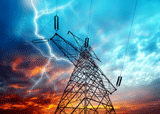In cases where back-up power is unnecessary, a sag compensator provides superior protection and additional power quality functions, such as protecting against sags, over/under voltage, and voltage fluctuations.

Modern industry is becoming more automated and the sensitivity of processes to power quality events is increasing.
It is generally recognised that quality is one of the most important parts of an electricity service. Not only are low prices important, high quality continuous supply also matters to customers. Price and quality are often complementary as together they define the value that customers derive from consuming electricity.
Companies are more sensitive to power quality issues because of the problems they cause within their immediate environment - from damage to equipment to the interruption of a production cycle, for example.
The most common of all power quality disturbances is voltage sag (or dip): more than 60% of poor power quality costs are a consequence of voltage sags. The cost normally associated with sags is lower than a voltage supply interruption, and their incidence increases with the use of sophisticated and electronic appliances.
What are voltage sags
Voltage sags are the temporary reduction of the voltage RMS below a specific threshold at an electrical supply line point.

Voltage sags are generally caused by faults in the public network or in the installations of electricity network users; in a few cases, the cause is by transient overloads due to the gearing up of large motors or the switching on of large loads. Voltage sags are also unpredictable and random.
Sags start when the voltage goes lower than 90% of nominal value and ends when voltages resume above 90%. A voltage sag’s duration is considered within the range of 10ms up to 1 min.
The majority of voltage sags have a duration lower than 1 second and a residual voltage higher than 40% of the rated value.
The voltage sag propagates from higher voltage levels compared to lower ones; the load is often connected to a voltage level lower than the point of failure. Faults in the network cause deep voltage sags if they occur near loads. The incidence of voltage sags is much greater in the case of an aerial MV network than with underground cables.
Relevance of voltage sags
With the incorporation of electronic equipment the more serious are the problems caused through voltage sag. With the increasing number of regenerative energy sources, energy sags, fluctuations and frequency deviations also increase.
Example of costs due to voltage sags:
-
Costs for unproductive personnel due to the sudden termination of a production cycle.
-
Costs for raw materials and production lost.
-
Costs for damages and/or malfunctions of machineries (repairs to them; temporary hire of new ones).
-
Penalties caused by contractual shortcomings.
-
Sanctions for damage to the environment.
-
Increase in general insurance costs.
Voltage sag solution
Many businesses require immunity to voltage sags and voltage conditioning rather than using the battery back-up power provided by a UPS system. In cases where back-up power is unnecessary, a sag compensator provides superior protection and additional power quality functions, such as protecting against sags, over/under voltage, and voltage fluctuations.
Moreover, protecting a whole plant via UPS, while immunising against sags, may be costly due to battery and maintenance costs.
The right solution is the sag compensator, which permits sag correction up to -50% for 1 minute.
This economical solution requires no maintenance and operational costs as no battery energy storage is required and efficiency >98% at nominal power.
Learn more about voltage sag here
Contact a UK Distributor